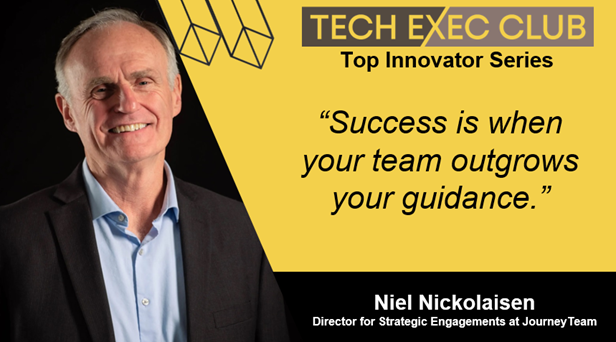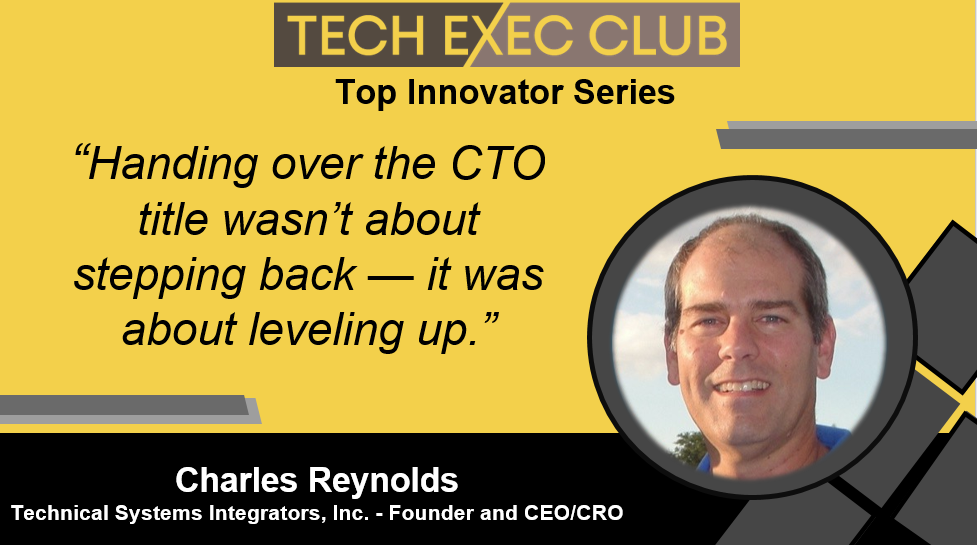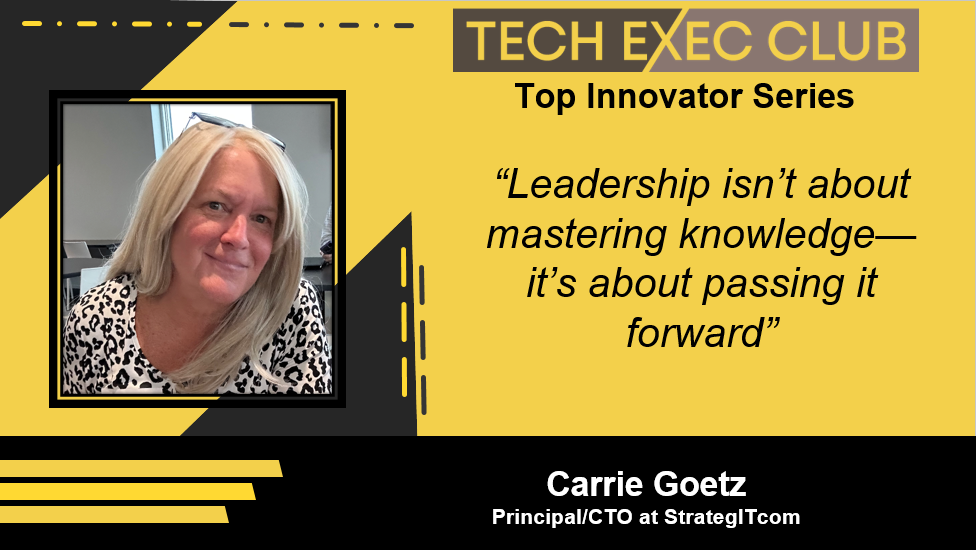In a world where many leaders still see employees as cogs in a machine, Mike Brown offers a refreshing, human-centered approach to leadership. As the CIO of Lackawanna County, Pennsylvania, and a seasoned mentor and educator, Mike has built a career on the belief that outstanding leadership is less about command and control and more about Adaptability, trust, and genuine connection.
In a candid conversation with Josef Martens on the Top Innovator Series, Mike shared his leadership journey—one shaped not by rigid formulas but by constant learning and Adaptability. From managing multi-generational teams in his early twenties to driving organizational change today, Mike has embraced a philosophy he calls “rock soup leadership”: you start with what you have and continuously add the ingredients needed to help your team thrive.
Throughout his career, Mike has discovered that success depends not just on technical expertise or strategic planning but on fostering inclusion, reading the subtle signals teams send—especially when they fall silent—and turning hierarchical meetings into honest, open conversations. His mission is to build organizations that don’t just pursue profit but also grow people, valuing employees as essential partners in success.
Mike’s story powerfully reminds us that leadership is a living process. It requires Adaptability, empathy, and a commitment to building workplaces where people are heard, understood, and empowered to succeed.
Leadership Is a Recipe—And Adaptability Is the Key Ingredient
Ask most people what makes a great leader, and they’ll often give you a checklist: vision, communication, decision-making. However, for Mike Brown, leadership is not a list—it’s a recipe, and the ingredients are constantly changing.
“I call it rock soup,” Mike explains with a smile. “You start with what you have, and as the situation changes, you keep adding to it until it comes together.”
From his earliest days moving up the leadership ladder, Mike resisted the urge to cling to rigid approaches. In every new role—whether in the private sector or public government—he looked for mentors and role models who could offer different perspectives. CFOs, CIOs, and even lower-level peers contributed insights that Mike wove into his evolving leadership style.
One key insight stayed with him: Adaptability is non-negotiable. “If you stick to one mindset, you will miss everything else,” he says. “Your job as a leader is to stay aware of the bigger picture, not just your original plan.”
“A leader leads from the front and the middle but never behind.” It is not always applicable to lead from the front (due to your own responsibilities) but a leader should try from time to time. Understanding the impact of your words and how your team interpret it, may shock you. By leading from the front, you can ensure they understand the objective and can easily realign the team to achieve the goal you set for them.
Leading from the middle, you are in the trenches with your team and you can see where the misalignment of expended energy is or rejoice with them to encourage their progress to reach the now achievable goal. By leading from the front (sometimes) and the middle (primarily), you build trust and understanding as you see what they see and you do not react to failed initiatives, you adjust and move forward.
When you lead from behind, you show your team that reaching the goal is your focus. The hard work was necessary and now get ready to do it again. Failure lies solely on the team and not leadership, because you could not see it coming being so far behind them. They shielded you from the inevitability of failure that you cannot explain.
Adaptability wasn’t just a theory for Mike. It became a survival skill. When shifting from teaching to leading, from IT roles to executive leadership, and from industry to government, Adaptability allowed him to keep learning and remain relevant. He noticed that leaders who resisted change often disconnected from their teams—and, eventually, their organizations.
“If you’re not willing to learn and evolve, you put an expiration date on yourself,” Mike warns. And that expiration date comes quickly in the fast-changing world of technology and management.
The Power of Inclusion and Trust in Leading Teams
Mike’s theory of adaptable leadership was tested early—and under challenging circumstances. At 23, he was promoted to lead a team of five experienced employees, all older than he was. Some knew he had been brought in to “shake things up.” Resentment was palpable.
“They knew my job was to assess the team and make necessary changes,” Mike recalls. “It wasn’t exactly a warm welcome.”
Many young leaders in his position might have asserted their authority or tried to prove their superiority. Mike chose a different path: vulnerability and inclusion.
“I admitted right away—I didn’t know everything,” he says. “I asked them to walk me through what they did. To teach me.”
That simple, honest approach disarmed the team. Rather than feeling threatened, they engaged in teaching and improving the process. “It turned potential adversaries into collaborators,” Mike explains.
Through open conversations, the team started identifying inefficiencies together. They co-created new guidelines and practices. When changes were implemented, the team was invested in the outcome rather than feeling like victims of top-down decisions.
Mike’s early experience shaped his belief that trust is earned, not granted by position. Leaders can turn even the toughest skeptics into allies by involving team members in decisions and being transparent about goals.
Learning to Read People and the Silent Signals
As Mike advanced into more senior roles, he learned that leading teams wasn’t just about listening to what people said. It was also about recognizing what they weren’t saying.
“People show you who they are—not necessarily by what they say, but by how they act,” Mike explains. “You must learn to read the room, especially when it’s silent.”
This became one of his guiding leadership principles. Silence in a meeting rarely means consensus. More often, it indicates hesitation, disagreement, or even fear. Leaders who mistake silence for agreement risk making decisions that alienate their teams or create unseen resistance.
Mike honed his skills in non-verbal communication, watching for body language, microexpressions, and other subtle cues. He also became skilled at managing his emotional responses.
“When someone challenges you or even tries to provoke a reaction, you need to stay level-headed,” he says. “Never take it personally.”
Mike believes the ability to read people—and create space for honest feedback—can make or break a leader. Teams need to feel safe expressing concerns, even difficult ones. By noticing silent resistance and addressing it early, Mike often avoided the larger conflicts that trip up many organizations.
This skill became especially valuable as Mike led larger, more complex teams. Understanding the silent signals helped him maintain trust, foster collaboration, and navigate the human side of organizational change.
Creating a Culture of Conversation, Not Just Compliance
In many organizations, meetings are a ritual—a box to be checked rather than a platform for honest dialogue. Mike sees this as a significant flaw in traditional leadership structures.
“We need to stop the canned meetings,” he says. “Instead of just a meeting, we’re having a conversation.”
For Mike, the difference is profound. Meetings focused on compliance lead to superficial updates and performative agreement. Conversations encourage team members to engage deeply, challenge assumptions, and propose innovative solutions.
“A manager who won’t take feedback is not a great manager—or a leader in any sense,” Mike states firmly.
Throughout his career, Mike worked to transform the culture of meetings. He encouraged open-ended discussions, removed punitive dynamics, and reframed even difficult conversations as opportunities for growth. He also pushed back against “status meetings” that yielded no actionable outcomes.
One of his proudest leadership moments came when employees who had been previously disengaged began actively contributing ideas and improvements during team conversations. By shifting from a culture of compliance to a culture of dialogue, Mike unlocked his teams’ creativity and strengthened their sense of ownership.
The Vision: Building Organizations That Grow People, Not Just Profits
While many leaders focus solely on driving profit, Mike’s leadership philosophy goes deeper. His ultimate goal is building organizations prioritizing growth—for the company and its people.
“Your employees are not disposable assets,” he says. “They’re helping you drive your profits. So invest in them like they’ve invested in you.”
This belief underpins Mike’s leadership style and academic pursuits. As he works toward his PhD in industrial organizational psychology, Mike explores how to create workplaces where employees are seen as partners in success—not replaceable parts.
His vision is clear: cultivate organizations where managers and employees work together as a community, where the company’s goals and employees’ personal growth are aligned, where learning and career development are continuous, and where leadership is measured not just by revenue growth but by the positive impact on people’s lives and careers.
“I don’t want a team of yes people or a business cult,” Mike says. “I want synergy. I want to build a culture where everyone grows together.”
For Mike Brown, leadership is not just about what you accomplish. It’s about who you help others become.
Mike Brown’s experience offers clear and actionable guidance for leaders, managers, and organizations looking to create empowered, adaptable teams.
Here’s how to put his leadership lessons into practice:
1. Embrace Adaptability as a Leadership Principle: Avoid rigid thinking. Be willing to revise your leadership approach as circumstances change. Continuously learn. Seek mentors, role models, and even lessons from your team members. View leadership as an evolving recipe, not a static formula. Success requires constant adjustment.
2. Build Trust Through Inclusion and Vulnerability: Admit when you don’t have all the answers. Humility invites collaboration. Involve your team in decisions. Let them contribute to identifying problems and designing solutions. Create shared ownership. Help team members feel invested in the outcomes.
3. Learn to Read the Room—Even When It’s Silent: Watch for nonverbal cues. Pay attention to body language and silence during meetings. Don’t mistake silence for agreement. Ask clarifying questions to surface hidden concerns. Manage your emotions. Stay calm and objective, especially in tense situations.
4. Foster a Culture of Conversation, Not Compliance: Transform meetings into open conversations. Ditch status updates for discussions that encourage feedback and innovation. Encourage constructive criticism. Questioning and challenging ideas are not only allowed but welcomed. Replace hierarchy with dialogue. Create spaces where everyone feels their voice matters.
5. Invest in People, Not Just Processes: See employees as partners, not resources. Recognize their contributions to organizational success. Support career growth. Provide learning and development opportunities tailored to individual goals. Align organizational and personal growth. Build a culture where business success and employee success go hand in hand.
6. Redefine Success: Value not only profits but people’s development. Measure success by how your leadership impacts lives and careers. Encourage community over compliance. Foster teams that grow together and support each other.
Mike Brown’s leadership journey is a testament to the power of Adaptability, inclusion, and human connection. From his early days leading older, skeptical teams to his current role shaping organizational culture and mentoring future leaders, Mike has demonstrated that effective leadership is not about wielding authority but building trust, fostering open dialogue, and investing in people’s growth.
By embracing vulnerability, learning to read beyond words, and turning meetings into meaningful conversations, Mike has cultivated teams that don’t just meet expectations—they exceed them. His unwavering belief that employees are not disposable assets but valued partners has shaped a leadership philosophy rooted in empowerment, resilience, and continuous learning.
As Mike continues his mission—both in his professional role and through his doctoral studies—he challenges leaders everywhere to rethink success. He sees it not as pursuing profit alone but as creating environments where individuals and organizations grow together.
His story reminds us that great leaders don’t just lead. They inspire, listen, and help others become leaders.
Want to hear Mike Brown’s insights firsthand? Watch the full, live podcast interview [click here]





